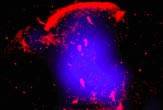
Huge collisions between galaxy clusters may spawn some of the fastest-moving, most energetic particles in the universe, a new study finds.
These high-energy subatomic particles, known as cosmic rays, scream through space at near the speed of light — about 186,000 miles (300,000 km) per second. They're mostly protons, and some pack enough punch to knock out electrical systems when they slam into Earth.
The new research shows that the most powerful cosmic rays may be super-accelerated to incredible velocities while riding the massive, long-lasting shockwaves caused by colliding galaxy clusters. [Gallery: When Galaxies Collide]
"In our own Milky Way, we know of no sources that could generate such energetic particles," said lead author Reinout van Weeren of Leiden University in the Netherlands. "Now we have documented one possible source."
Scanning the radio sky
Using observations from three different radio telescopes, van Weeren and his colleagues discovered a huge arc of radio-wavelength emissions in a sliver of sky. The arc is slender, but enormously long — it spans about 6.5 million light-years, making it more than 60 times greater than the width of our Milky Way galaxy.
The arc is located on the northern outskirts of a galaxy cluster known as CIZA J2242.8+5301, about 2.5 billion light-years from Earth. The astronomers also found a smaller sister arc on the cluster's southern side.
Get the world’s most fascinating discoveries delivered straight to your inbox.
Previous research by other astronomers has shown that CIZA J2242.8+5301 is stretched out, indicating it is merging with another cluster. Such galaxy mergers are dramatic events, with great swarms of galaxies crashing together to form a single superstructure. They have other dramatic consequences, too.
"Galaxy clusters are the biggest objects in the universe," van Weeren told SPACE.com. "If you collide two of them, you get an enormous shock wave."
The galaxy clusters are embedded in a medium of dense gas, van Weeren said. As the shock wave expands, it propagates through this medium much like a sonic boom propagates through air when an airplane breaks the sound barrier, he added.
Shock-wave tracer
Scientists have previously suspected that cluster-collision shock waves could accelerate particles to enormous energies. Protons and electrons — contained by magnetic fields on either side of the shock wave — should bounce back and forth across the shock, moving faster and faster over time before finally escaping.
And, as the theory goes, there should be a telltale signature of such an event: The fast-moving electrons should emit radiation as they twist, turn and accelerate in the wave.
The new findings confirm this theoretical work, researchers said.
The radio arcs are direct tracers of the shock wave, and these so-called "radio relics" provide evidence that the wave has accelerated particles to near the speed of light.
"Just from the shape, you can almost immediately tell it results from a shock wave," van Weeren said.
The team also performed computer simulations on CIZA J2242.8+5301, modeling its merger and shock wave. The team's observations matched up precisely with the model's predictions, the researchers said.
The research is detailed in the Sept. 23 online edition of the journal Science.
Accelerating for a billion years
Scientists think many cosmic rays come from supernova explosions in our own galaxy. But some particles are just too energetic for this explanation, van Weeren said.
In 1991, for example, a detector in Utah snagged a cosmic ray with a kinetic energy of about 50 joules — about the same as a baseball traveling at 60 mph (97 kph).
The new study suggests that some of these ultra-energetic particles may come from cluster mergers far, far away from Earth.
Shock waves like CIZA J2242.8+5301's can last for more than 1 billion years, the researchers said. That's plenty of time for particles to get revved up to near light speed.
The finding also shows that astronomers can probably pinpoint more shock waves by scanning the heavens for radio relics, the researchers said.
If astronomers can find more shock fronts, they may be able to get a better handle on cluster collisions, dramatic events that alter the structure of huge stretches of the universe, they added.



